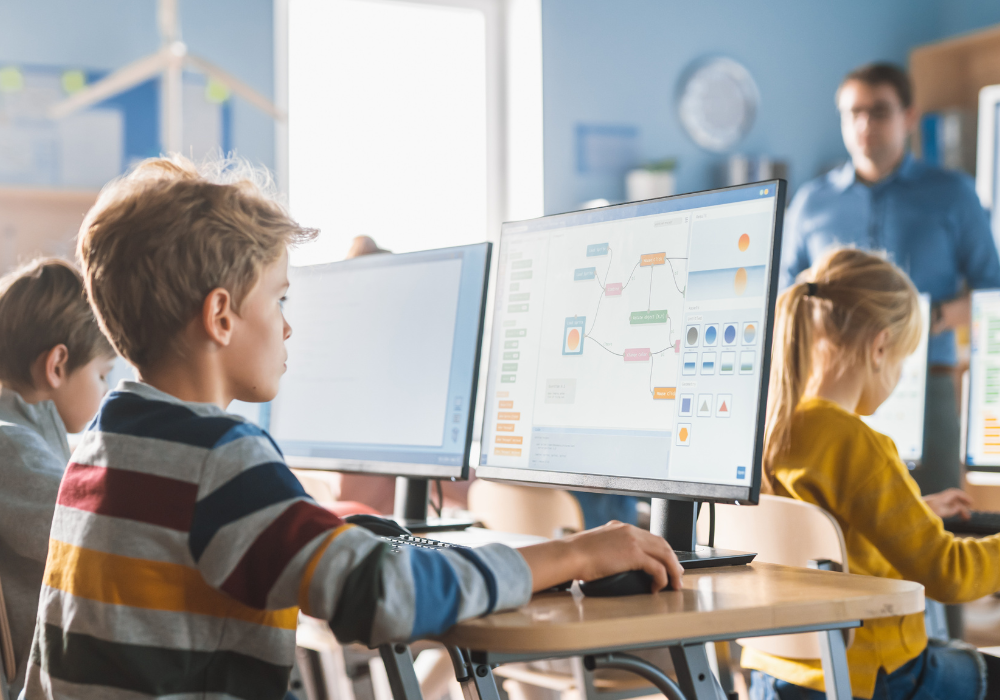
New Age of Ed-tech
15.06.22Education is undergoing a tech-field renaissance. The future of learning will be driven by access to new technologies and digital content, on-demand and on our terms. The internet, mobile and social media have changed our lives. New emerging tools and platforms allow us to pursue our own educational goals. Ed-tech tools will continue to transform how we teach and learn. Traditional educational institutions are now looking to get equipped to keep up with the pace of technological changes.
New Ed-tech technologies can change how education is perceived, delivered, and accessed. These technologies open a world of possibility to people who want to take control of their education. Online learning tools are proliferating. Virtual reality gadgetry will change how we teach and learn today. AR and VR learning will be a boon for students with special needs.
Through technology, students’ learning journeys get mapped, which helps them analyse their shortcomings as they begin constructing the fundamental concept of comprehending a subject. Until fundamentals are not understood correctly, moving forward and learning newer and more complex topics makes no sense for a student. However, through the help of ed-tech, the students’ learning journey is always mapped, which helps to predict and suggest what students need to learn more. Only then will learners move forward on their learning journey.
Today, technology allows us to retract the trajectory of a learner’s shortcomings and focus on getting their fundamentals right. So, for example, if a student has failed in maths, the reason could be that he does not have the basics of English in place even to comprehend the question in the first place; solving the question is the next step. It further helps to take constructive and corrective measures to resolve the issues for the student during their learning journey. Students must move away from mugging and learning and route their learning strategy, methods and focus to making their core strong through experiential methods. Children will get ready for competitive exams in future by moving away from the traditional methods and embracing the new-age learning.
A deep diagnostic and understanding of the learner’s behaviour gets accessed through ed-tech. Then accordingly, a recommendation for better learning helps the student finish and learn the subject or concept in detail. Then, the learner is introduced to newer concepts using interactive technologies to ensure that students build a deeper, faster, and better understanding of any concept or subject.
Imagine kids obsessed with English as a subject and are keen on becoming writers, however they have a weak understanding of Parts of Speech in English grammar. This will slow their pace of learning until they don’t get their basic fundamentals of parts of speech right. It will be a crucial factor in defining the pace at which they form a strong base for sentence construction to write flawless sentences. Therefore ed-tech helps students understand their weaknesses while studying a subject and directs them to continuously work and practice to increase their pace and learning content they find fun and engaging. Today, most students prefer to control how they like to learn by choosing what content they find interesting. What’s happening in the digital world of content means that we can infer what kind of education is coming next if we want to. One of the significant strengths of Augmented Reality (AR) is that it allows students to see and interact with an environment that learners can’t otherwise experience. These new-age technological tools help students map their journey, giving them deeper, faster and better learning of fundamentals of a subject and complex concept in the future.
AR and VR Learning tools put users into a fully immersive environment for an unprecedented learning experience. For example, students often must suspend their imagination to comprehend a concept in a traditional classroom. Study modules powered by Augmented Reality (AR) and virtual reality (VR) provide an experience that mimics real life as closely as possible, which helps learners grasp new concepts.
Today students are learning from the next generation of technologies. In 20 years, VR/AR and other new technologies will further change our education system and improve the learning process while providing unlimited opportunities to creative educators and students. In addition, technology is enabling new models of learning that are transforming education. Early adoption of these technologies will significantly help an individual learner to adopt to newer technologies seamlessly in future.
Blended learning is the new model of teaching. However, a one-size-fits-all model isn’t practical for all learners. The school experience should not get defined by a headteacher standing in a classroom with rows of children taking notes. Today technology is changing the way we learn and interact with knowledge and understanding. AR/ VR 3D Modelling will enhance the learning experience in STEM subjects such as Biology, Chemistry, Computer Science & Geography etc.
It is time that our educational institutions begin to embrace and harness the true power of technology. The possibility of a blended learning approach will only improve student performance and retention while simultaneously reducing costs associated with traditional methods. Moreover, through the broader adoption of augmented reality (AR) in schools, enhanced learning opportunities will increase student engagement and prepare students for real-world encounters. If educators make extra effort to rethink current educational standards considering emerging technologies, this should be no surprise. The beauty of technology is to leverage critical thinking and creativity to determine whether these emerging technologies will prove valuable as an effective supplement to traditional educational practices.
Learning without understanding the material and exploring its vast creative potential is a disservice to teachers and students. To enhance learning, using new-age tech tools can help reduce rote memorisation towards understanding why we study what we do instead of what it teaches us about the more incredible world around us.
As much as factories have been by computers, education is getting transformed by AR (Augmented Reality). The new generation of students will have the smartest, fastest and most efficient learning systems at their fingertips to help them learn things better and faster than humans can on their ow.
Augmented Reality (AR) is undoubtedly poised to revolutionise various sectors in a few years, so teachers and educators must note this. By adapting to new technologies, teachers can provide their students with learning opportunities like never before that are more real than a textbook and more practical than an expert. In addition, AR allows students to engage in environments unlike traditional classrooms and education methods, allowing students to recreate history or understand a text in context.
The future of education lies in the fact that relevant new technologies like AR/VR get appropriately applied. Understanding fundamentals and then comprehending complex concepts and subjects will get easier for students using these new-age ed-tech technological tools. Knowledge is a critical aspect of growth and achievement today.
By Yuvraj Krishan Sharma, www.kompanions.com
COPYRIGHT © Abode2 2012-2025











